 First US edition | |
| Author | H. G. Wells |
|---|---|
| Illustrator | Charles Allan Gilbert |
| Country | United Kingdom |
| Language | English |
| Publisher | Cassell (UK) Macmillan (US) |
Publication date | 1917 |
| Pages | 341 |
The Soul of a Bishop is a 1917 novel by H. G. Wells.
 First US edition | |
| Author | H. G. Wells |
|---|---|
| Illustrator | Charles Allan Gilbert |
| Country | United Kingdom |
| Language | English |
| Publisher | Cassell (UK) Macmillan (US) |
Publication date | 1917 |
| Pages | 341 |
The Soul of a Bishop is a 1917 novel by H. G. Wells.
The Soul of a Bishop tells the story of a spiritual crisis that leads Edward Scrope, Lord Bishop of Princhester, to give up his diocese in England's industrial heartland and leave the Anglican Church. Troubled during World War I by doctrinal doubts and a sense of the irrelevance of his Anglicism as well as nervousness and insomnia, a crisis is precipitated by a visit to a wealthy parishioner's home where he meets an extremely wealthy American widow, Lady Sunderbund. To her he speaks for the first time of his religious discontent. Shortly thereafter he takes a drug that, instead of mitigating his symptoms, gives him "a new and more vivid apprehension of things." [1] The bishop experiences a mystical vision of "the Angel of God" and then God in the North Library of the Athenaeum Club, London. [2] He emerges from the experience convinced that he must leave the Church, but is persuaded by an old mentor, Bishop Likeman, to wait three months before doing anything, during which time he continues in his episcopal duties.
Bishop Scrope keeps these developments from his wife, Lady Ella, and his four daughters until Lady Sunderbund arrives unannounced in Princhester, vowing to become his spiritual pupil. The strain of this new situation leads him to take Dr. Dale's drug a second time, and under its influence he has a second vision, this time of the terrestrial globe in a state of spiritual ferment to which the world's clergy is not ministering. Under the influence of this revelation he delivers a heretical confirmation address in the cathedral and resolves thereafter to leave the Church. Lady Sunderbund wishes to devote her riches to helping him found a new church, but in the process of developing plans for it Scrope realizes, in a third vision that this time is not mediated by any drug, that in the new religion he must serve "there must be no idea of any pulpit, of any sustained mission." [3] In a final epiphany, he realizes that his refusal to "trust his family to God" has been holding him back, and that "this distrust has been the flaw in the faith of all religious systems hitherto." [4] Five years after it began, Scrope's spiritual crisis is resolved.
The Soul of a Bishop is a novelistic treatment of themes Wells developed in another book published the same year, God the Invisible King . In that volume, which was widely discussed at the time, as in The Soul of a Bishop, Wells rejects the theological doctrine of the Trinity that he attributed to the Council of Nicaea (the novel opens with Scrope dreaming about the Council of Nicaea).
Wells experienced a religious conversion during World War I; his biographer David C. Smith reports that this conversion "did not last long, and mirrored somewhat similar experiences widely recorded in France and England" that were provoked by the war. [5] These beliefs proved to be only a passing phase; "[e]ssentially . . . Wells had tried Christianity again, albeit in a version much altered from that normally taught, and had found it wanting." [6] Another biographer, Vincent Brome, wrote that "within a few years, [Wells's] natural streak of Voltairian anti-clericalism had re-asserted itself with all its old vigour. Later in life he was a little uneasy about the lapse." [7]

The First Council of Nicaea was a council of Christian bishops convened in the Bithynian city of Nicaea by the Roman Emperor Constantine I. The Council of Nicaea met from May until the end of July 325.

Teresa of Ávila, OCD, also called Saint Teresa of Jesus, was a Carmelite nun and prominent Spanish mystic and religious reformer.
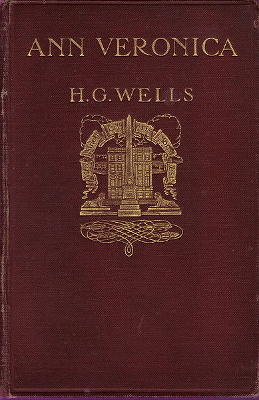
Ann Veronica is a novel by H. G. Wells published in 1909. It describes the rebellion of Ann Veronica Stanley, "a young lady of nearly two-and-twenty", against her middle-class father's stern patriarchal rule. The novel dramatizes the contemporary problem of the New Woman. It is set in Edwardian era London and environs, except for an Alpine excursion. Ann Veronica offers vignettes of the women's suffrage movement in Great Britain and features a chapter inspired by the 1908 attempt of suffragettes to storm Parliament.

Our Lady of Fátima is a Catholic title of Mary, mother of Jesus, based on the Marian apparitions reported in 1917 by three shepherd children at the Cova da Iria in Fátima, Portugal. The three children were Lúcia dos Santos and her cousins Francisco and Jacinta Marto. José Alves Correia da Silva, Bishop of Leiria, declared the events worthy of belief on 13 October 1930.
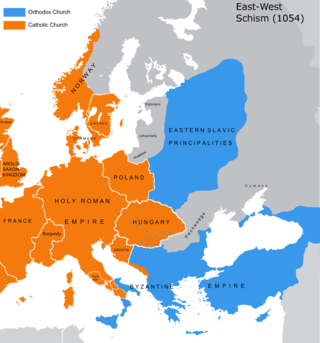
The East–West Schism, also known as the Great Schism or the Schism of 1054, is the break of communion between the Catholic and Eastern Orthodox churches since 1054. A series of ecclesiastical differences and theological disputes between the Greek East and Latin West preceded the formal split that occurred in 1054. Prominent among these were the procession of the Holy Spirit (Filioque), whether leavened or unleavened bread should be used in the Eucharist, iconoclasm, the coronation of Charlemagne as Emperor of the Romans in 800, the Pope's claim to universal jurisdiction, and the place of the See of Constantinople in relation to the pentarchy.
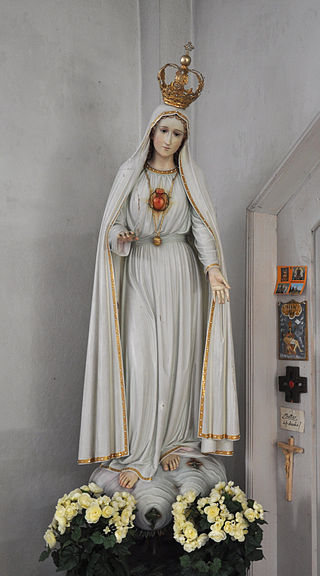
The Three Secrets of Fátima are a series of apocalyptic visions and prophecies reportedly given to three young Portuguese shepherds, Lúcia Santos and her cousins Jacinta and Francisco Marto, by a Marian apparition, starting on 13 May 1917. The three children claimed to have been visited by the Virgin Mary six times between May and October 1917. The apparition is now popularly known as Our Lady of Fátima.

Adam de Brome was an almoner to King Edward II and founder of Oriel College in Oxford, England. De Brome was probably the son of Thomas de Brome, taking his name from Brome near Eye in Suffolk; an inquisition held after the death of Edmund, 2nd Earl of Cornwall, in 1300, noted de Brome holding an inheritance of half a knight's fee.

Charles Gore was a Church of England bishop, first of Worcester, then Birmingham, and finally of Oxford. He was one of the most influential Anglican theologians of the 19th century, helping reconcile the church to some aspects of biblical criticism and scientific discovery, while remaining Catholic in his interpretation of the faith and sacraments. Also known for his social action, Gore became an Anglican bishop and founded the monastic Community of the Resurrection as well as co-founded the Christian Social Union. He was the chaplain to Queen Victoria and King Edward VII.

During the reign of the Roman Emperor Constantine the Great, Christianity began to transition to the dominant religion of the Roman Empire. Historians remain uncertain about Constantine's reasons for favoring Christianity, and theologians and historians have often argued about which form of early Christianity he subscribed to. There is no consensus among scholars as to whether he adopted his mother Helena's Christianity in his youth, or, as claimed by Eusebius of Caesarea, encouraged her to convert to the faith he had adopted.

Sundar Singh, who was actually commonly referred to as Sadhu Sundar Sing, was an Indian Christian missionary and sadhu. He is believed to have died in the foothills of the Himalayas in 1929.
Written in the late 19th century by H. G. Wells and first published in The Butterfly, and collected in The Obliterated Man and Other Stories, "A Vision of Judgment" is a short story in 9 sections. It portrays a Last Judgment in which God and the archangel Gabriel laugh at sinners and saints alike, embarrassing them until they flee "up the sleeve of God." After every human soul has taken shelter there, all of humanity, "enlightened" and "in new clean bodies," is given a second chance. God shakes them—or rather us—"out of his sleeve upon the planet he had given us to live upon, the planet that whirled about green Sirius for a sun," saying "now that you understand me and each other a little better. . . . try again."
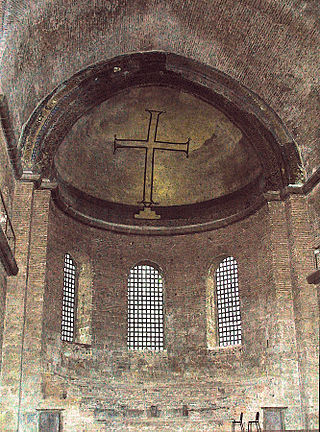
The Byzantine Iconoclasm were two periods in the history of the Byzantine Empire when the use of religious images or icons was opposed by religious and imperial authorities within the Ecumenical Patriarchate and the temporal imperial hierarchy. The First Iconoclasm, as it is sometimes called, occurred between about 726 and 787, while the Second Iconoclasm occurred between 814 and 842. According to the traditional view, Byzantine Iconoclasm was started by a ban on religious images promulgated by the Byzantine Emperor Leo III the Isaurian, and continued under his successors. It was accompanied by widespread destruction of religious images and persecution of supporters of the veneration of images. The Papacy remained firmly in support of the use of religious images throughout the period, and the whole episode widened the growing divergence between the Byzantine and Carolingian traditions in what was still a unified European Church, as well as facilitating the reduction or removal of Byzantine political control over parts of the Italian Peninsula.
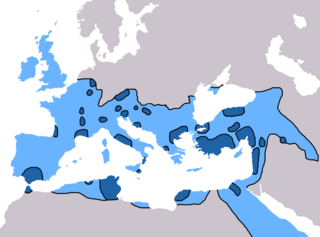
Christianity in the 4th century was dominated in its early stage by Constantine the Great and the First Council of Nicaea of 325, which was the beginning of the period of the First seven Ecumenical Councils (325–787), and in its late stage by the Edict of Thessalonica of 380, which made Nicene Christianity the state church of the Roman Empire.

Mr. Britling Sees It Through is H.G. Wells's "masterpiece of the wartime experience in south eastern England." The novel was published in September 1916.

Marriage is a 1912 novel by H. G. Wells.
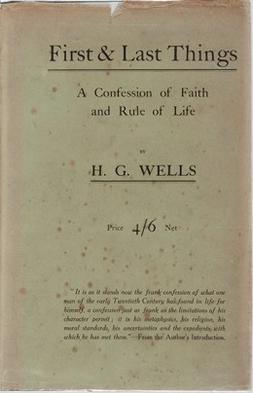
First and Last Things is a 1908 work of philosophy by H. G. Wells setting forth his beliefs in four "books" entitled "Metaphysics," "Of Belief," "Of General Conduct," and "Some Personal Things." Parts of the book were published in the Independent Magazine in July and August 1908. Wells revised the book extensively in 1917, in response to his religious conversion, but later published a further revision in 1929 that restored much of the book to its earlier form. Its main intellectual influences are Darwinism and certain German thinkers Wells had read, such as August Weismann. The pragmatism of William James, who had become a friend of Wells, was also an influence.
The Wife of Sir Isaac Harman is a 1914 novel by H. G. Wells.

God the Invisible King is a theological tract published by H. G. Wells in 1917.

The Bulpington of Blup is a 1932 novel by H. G. Wells. It is a character study analyzing the psychological sources of resistance to Wellsian ideology, and was influenced by Wells's acquaintance with Carl Gustav Jung and his ideas.

Joan and Peter, a 1918 novel by H. G. Wells, is at once a satirical portrait of late-Victorian and Edwardian England, a critique of the English educational system on the eve of World War I, a study of the impact of that war on English society, and a general reflection on the purposes of education. Wells regarded it as "one of the most ambitious" of his novels.